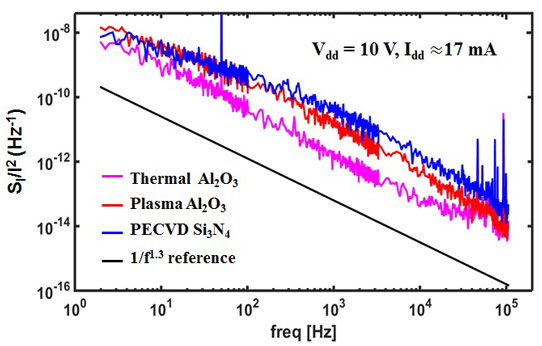- News
10 March 2015
Reducing low-frequency noise in AlInN/GaN HEMTs
Researchers based in Sweden and France have been exploring various passivations for reducing low-frequency noise (LFN) in gallium nitride (GaN) high-electron-mobility transistors (HEMTs) with aluminium indium nitride (AlInN) barriers [Thanh Ngoc Thi Do et al, IEEE Electron Device Letters, published online 6 February 2015]. The researchers claim that one of their passivation processes produced the best reported LFN for AlInN/GaN HEMTs.
Passivation reduces surface traps and gate leakage with the aim of improving performance in terms of current collapse (low on-current after switching), transconductance, pinch-off, power, memory effects, and LFN. Different passivations affect these performance features to different extents.
HEMTs with AlInN barriers are seen as potential devices for high-power high-frequency applications in the millimeter-wave spectrum, beyond the performance of commercial GaN HEMTs with AlGaN barriers.
The research was carried out at Chalmers University of Technology in Sweden and 3-5 Lab/Thales Research & Technology in France, with funding from the Swedish government, along with RUAG AB and Ericsson AB.
The heterostructures consisted of a 6nm aluminium indium nitride (Al0.81In0.19N) barrier, a 2nm aluminium nitride spacer, a 1.6μm gallium nitride (GaN) channel/buffer, and a 100nm nucleation layer, grown on silicon carbide (SiC) by metal-organic chemical vapor deposition (MOCVD).
The researchers fabricated devices with plasma-etched mesas, annealed tantalum-based ohmic contacts, 100nm annealed nickel/gold gates, titanium/gold contact pads, and passivation. The source-drain separation was 1μm. The mesas were 2μmx50μm.
Three different passivation processes were tested. Two involved deposition of aluminium oxide (Al2O3); the other used silicon nitride (Si3N4). The Al2O3 was applied using either thermal or plasma-enhanced 300°C atomic layer deposition (ALD). The Si3N4 resulted from a 340°C plasma-enhanced chemical vapor deposition (PECVD).
The noise measurements were carried out at a high drain bias of 10V with a view to oscillator and amplifier applications that often operate HEMTs in the saturation region. The current operation point was around 17mA. The gate bias was swept to generate noise spectra normalized by the square of the current (Figure 1). The HEMT with thermal ALD Al2O3 showed the lowest noise levels with a spectrum that fell as an inverse 1.3-power of frequency up to 50kHz. A plateau beyond 50kHz was attributed tentatively to generation-recombination noise. The 'Lorentzian type' noise of the other two devices indicated the presence of deep-level traps.

Figure 1: Drain noise current spectra of the three AlInN/AlN/GaN HEMTs versus frequency at 10V, 17mA operating point.
The 10kHz noise of the three device types were similar at low drain currents, but at high currents the thermal ALD Al2O3 was better by an order of magnitude than the plasma ALD passivated HEMT. The SiN PECVD passivation had a factor of 50 higher noise than the thermal ALD Al2O3 at high current. The thermal AlD Al2O3 HEMT had a noise current spectral density of 1x10-14/Hz at 10kHz with a bias of 10V and 80mA.
The researchers comment that the noise levels are also comparable to commercial and state-of-the-art AlGaN/GaN HEMTs. They add: "It is found that the thermal ALD HEMT performs well in comparison, even though the technology is less mature."
The output power performance in 3GHz load-pull measurements of the three devices was 1.9W/mm for thermal Al2O3, 3.3W/mm for plasma Al2O3, and 2.4W/mm for PECVD Si3N4. The researchers describe the trade-off between noise and output power as "interesting". They add: "For oscillator applications, the thermal ALD HEMT is much more suitable due to its significantly lower flicker noise level. Assuming flicker noise to be the dominant noise source, the 10-50 times improvement in noise spectral density would result in more than 10dB improvement in oscillator phase noise while the difference in power density between the three samples would affect phase noise by less than 3dB."
AlInN/GaN HEMTs GaN HEMTs SiC MOCVD ALD
http://ieeexplore.ieee.org/xpl/articleDetails.jsp?arnumber=7035032
The author Mike Cooke is a freelance technology journalist who has worked in the semiconductor and advanced technology sectors since 1997.


